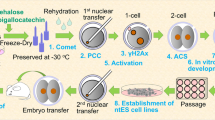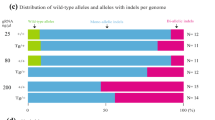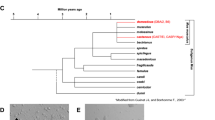Abstract
Mammalian cloning using somatic cells has been accomplished successfully in several species, and its potential basic, clinical and therapeutic applications are being pursued on many fronts. Determining the long-term effects of cloning on offspring is crucial for consideration of future application of the technique. Although full-term development of animals cloned from adult somatic cells has been reported, problems in the resulting progeny indicate that the cloning procedure may not produce animals that are phenotypically identical to their cell donor. We used a mouse model to take advantage of its short generation time and lifespan. Here we report that the increased body weight of cloned B6C3F1 female mice reflects an increase of body fat in addition to a larger body size, and that these mice share many characteristics consistent with obesity. We also show that the obese phenotype is not transmitted to offspring generated by mating male and female cloned mice.
This is a preview of subscription content, access via your institution
Access options
Subscribe to this journal
Receive 12 print issues and online access
$209.00 per year
only $17.42 per issue
Buy this article
- Purchase on Springer Link
- Instant access to full article PDF
Prices may be subject to local taxes which are calculated during checkout




Similar content being viewed by others
References
Wilmut, I., Schnieke, A.E., McWhir, J., Kind, A.J. & Campbell, K.H. Viable offspring derived from fetal and adult mammalian cells. Nature 385, 810–813 (1997).
Wakayama, T., Perry, A.C.F., Zuccotti, M., Johnson, K.R. & Yanagimachi, R. Full-term development of mice from enucleated oocytes injected with cumulus cell nuclei. Nature 394, 369–374 (1998).
Wakayama, T. & Yanagimachi, R. Cloning of male mice from adult tail-tip cells. Nature Genet. 22, 127–128 (1999).
Kato, Y. et al. Eight calves cloned from somatic cells of a single adult. Science 282, 2095–2098 (1998).
Galli, C., Duchi, R., Moor, R. & Lazzari, G. Mammalian leukocytes contain all the genetic information necessary for the development of a new individual. Cloning 1, 161–170 (1999).
Wells, D.N., Misica, P.M. & Tervit, H.R. Production of cloned calves following nuclear transfer with cultured adult mural granulosa cells. Biol. Reprod. 4, 996–1005 (1999).
Kubota, C. et al. Six cloned calves produced from adult fibroblast cells after long-term culture. Proc. Natl. Acad. Sci. USA 97, 990–995 (2000).
Polejaeva, I.A. et al. Cloned pigs produced by nuclear transfer from adult somatic cells. Nature 407, 86–90 (2000).
Coleman, A. Somatic cell nuclear transfer in mammals: progress and applications. Cloning 1, 185–200 (1999/2000).
Prather, R.S., Kuholzer, B., Lai, L. & Park, K.-W. Changes in the structure of nuclei after transfer to oocytes. Cloning, 2,117–122 (2000).
Solter D. Mammalian cloning: advances and limitations. Nature Rev. Genet., 1, 199–207 (2000).
Tsunoda, Y. & Kato, Y. The recent progress on nuclear transfer in mammals. Zoolog. Sci. 17, 1177–1184 (2000).
Wakayama, T. & Yanagimachi, R. Mouse cloning with nucleus donor cells of different age and type. Mol. Reprod. Dev. 58, 376–383 (2001).
Yamazaki, Y. et al. Assessment of the developmental totipotency of neural cells in the cerebral cortex of mouse embryo by nuclear transfer. Proc. Natl. Acad. Sci. USA 98, 14022–14026 (2001).
Yanagimachi, R. Cloning: experience from the mouse and other animals. Mol. Cell. Endocrinol. (in the press).
Renard, J.P. et al. Lymphoid hypoplasia and somatic cloning. Lancet 353, 1489–1491 (1999).
Ogura, A. et al. Production of male cloned mice from fresh, cultured, and cryopreserved immature sertoli cells. Biol. Reprod. 62, 1579–1584 (2000).
Shiels, P.G. et al. Analysis of telomeres lengths in cloned sheep. Nature 399, 316–317 (1999).
Evans, M.J. et al. Mitochondrial DNA genotypes in nuclear transfer-derived cloned sheep. Nature Genet. 23, 90 (1999).
Wakayama, T. et al. Cloning of mice to six generations. Nature 407, 318–319 (2000).
Lanza, R.P. et al. Extension of cell life-span and telomere length in animals cloned from senescent somatic cells. Science 288, 665–669 (2000).
Steinborn, R. et al. Mitochondrial DNA heteroplasmy in cloned cattle produced by fetal and adult cell cloning. Nature Genet. 25, 255–257 (2000).
Tian, X.C., Xu, J. & Yang, X. Normal telomere lengths found in cloned cattle. Nature Genet. 26, 272–273 (2000).
Ohgane, J. et al. DNA methylation variation in cloned mice. Genesis 30, 45–50 (2001).
Tamashiro, K.L.K., Wakayama, T., Blanchard, R.J., Blanchard, D.C. & Yanagimachi, R. Postnatal growth and behavioral development of mice cloned from adult cumulus cells. Biol. Reprod. 63, 328 (2000).
Humpherys, D. et al. Epigenetic instability in ES cells and cloned mice. Science 293, 95–97 (2001).
Eggan, K. et al. Hybrid vigor, fetal overgrowth, and viability of mice derived by nuclear cloning and tetraploid embryo complementation. Proc. Natl. Acad. Sci. USA 98, 6209–6214 (2001).
Young, L.E., Sinclair, K.D. & Wilmut, I. Large offspring syndrome in cattle and sheep. Rev. Reprod. 3, 155–163 (1998).
Young, L.E. et al. Epigenetic change in IGF2R is associated with fetal overgrowth after sheep embryo culture. Nature Genet. 27, 153 (2001).
Dulioust, E. et al. Long-term effects of embryo freezing in mice. Proc. Natl. Acad. Sci. USA 92, 589–593 (1995).
Turturro, A. et al. Growth curves and survival characteristics of the animals used in the Biomarkers of Aging Program. J. Gerontol. 54, B492–501 (1999).
The Jackson Laboratory. JAX Notes #468 442–444 (The Jackson Laboratory, Marketing Communications, Bar Harbor, Maine, 1997).
Baguisi, A. et al. Production of goats by somatic cell nuclear transfer. Nature Biotechnol. 17, 456–461 (1999).
Lanza, R.P. et al. Cloned cattle can be healthy and normal. Nature 294, 1893–1894 (2001).
Seeley, R.J. et al. Melanocortin receptors in leptin effects. Nature 390, 349 (1997).
Woods, S.C., Seeley, R.J., Porte, D. & Schwartz, M.W. Signals that regulate food intake and energy homeostasis. Science 280, 1378 (1998).
Schwartz, M.W., Woods, S.C., Porte, D., Seeley, R.J. & Baskin, D.G. Central nervous system control of food intake. Nature 404, 661–671 (2000).
Walker, S.K., Hartwich, K.M. & Seamark, R.F. The production of unusually large offspring following embryo manipulation: concepts and challenges. Theriogenology 45, 111–120 (1996).
Kikyo, N. & Wolffe, A.P. Reprogramming nuclei: insights from cloning, nuclear transfer and heterokaryons. J. Cell Sci. 113, 11–20 (2000).
Eggan, K. et al. X-Chromosome inactivation in cloned mouse embryos. Science 290, 1578–1581 (2000).
Inoue, K. et al. Faithful expression of imprinted genes in cloned mice. Science 295, 297 (2002).
Young, L.E. & Fairburn, H.R. Improving the safety of embryo technologies: Possible role of genomic imprinting. Theriogenology 53, 627–648 (2000).
Ensinck, J.W., Laschansky, E.C., Vogel, R.E. & D'Alessio, D.A. Effect of somtostatin-28 on dynamics of insulin secretion in perfused rat pancreas. Diabetes 40, 1163–1169 (1991).
Acknowledgements
We thank K. Ellis, L.Y. Ma, T. Osada and K. Smith for their contributions to this study. This work was supported by National Institutes of Health grants DK-48061 to R.R.S. and DK-17844 to S.C.W., the Victoria S. and Bradley L. Geist Foundation, the Kosasa Family Foundation and grants from the Katherine and Harold Castle Foundation to R.Y. The Obesity Research Center at the University of Cincinnati is supported by Procter & Gamble.
Author information
Authors and Affiliations
Corresponding author
Ethics declarations
Competing interests
The authors declare no competing financial interests.
Rights and permissions
About this article
Cite this article
Tamashiro, K., Wakayama, T., Akutsu, H. et al. Cloned mice have an obese phenotype not transmitted to their offspring. Nat Med 8, 262–267 (2002). https://doi.org/10.1038/nm0302-262
Received:
Accepted:
Issue Date:
DOI: https://doi.org/10.1038/nm0302-262
This article is cited by
-
Double sperm cloning (DSC) is a promising strategy in mammalian genetic engineering and stem cell research
Stem Cell Research & Therapy (2020)
-
Partial phenotype conversion and differential trait response to conditions of husbandry in mice
Journal of Comparative Physiology B (2018)
-
Abnormal gene expression in regular and aggregated somatic cell nuclear transfer placentas
BMC Biotechnology (2017)
-
Healthy ageing of cloned sheep
Nature Communications (2016)
-
The growth and reproduction performance of TALEN-mediated β-lactoglobulin-knockout bucks
Transgenic Research (2016)



